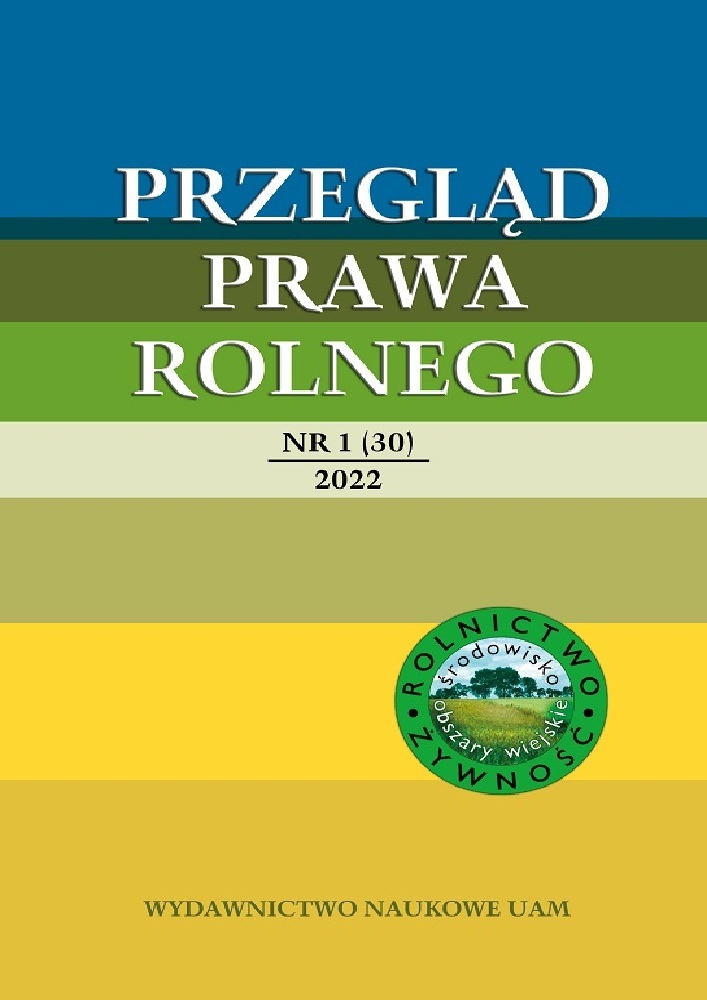Abstract
This article deals with the legislation regulating income from agriculture in Switzerland and in the EU. The provision of Article 5(1) of the Swiss Agriculture Act treats agricultural income similarly to incomes from other branches of economy This regulation, however, does not ensure farmers any income guarantee and is not enforceable in courts. The Common Agricultural Policy provisions are more general and also unenforceable. Article 39(1)(b) of the TFEU refers to a “fair standard of living for the agricultural community.” While the average agricultural income in Switzerland in the period 1997–1999 was only 52% of the comparative income, this percentage was already 66% by the period 2017–2019. The agricultural policy 22+ seeks to reduce this income gap even more. In the EU, the average income from agricultural activity increased from 32% in 2009 to 49% in 2017 of the comparative income from other branches and the new CAP policy 2022–2025 also seeks to reduce this income gap further. As can be seen, when compared to income in the economy as a whole, farmers’ income in Switzerland is substantially higher than in the EU. However, both Switzerland and the EU must undertake further efforts to comply with the current legal requirements to support legal income targets in agriculture.
References
Altermatt B. (1992), Förderung einer multifunktionalen Landwirtschaft unter veränderten Bedingungen, “Blätter für Agrarrecht” No 1.
Bittner C. (2019), in: U. Becker, A. Hatje, J. Schoo, J. Schwarze (eds.), EU-Kommentar, Baden-Baden.
Busse Ch. (2012), in: C.O. Lenz, K.-D. Borchardt (eds.), EU-Verträge, Kommentar, Köln – Wien.
Gubler T. (1986), Der kostendeckende Preis für landwirtschaftliche Erzeugnisse gemäss Art. 29 LwG – Seine Charakteristik und die Mittel zu seiner Erzielung, Basel – Zurich.
Härtel I. (2018), in: R. Streinz, W. Michel, EUV/AEUV, Munich.
Hofer E. (1996), Reform der Agrarpolitik (AP 2002) – Das neue Landwirtschaftsgesetz und dessen Entstehung, “Blätter für Agrarrecht” No 2–3.
Huser M. (1983), Die Gleichbehandlung der Landwirte durch die Sonderberücksichtigung der e schwerten Produktions- und Lebensbedingungen, Freiburg i.Ü.
Lehmann B., Briner S. (2016), Weiterentwicklung von Landwirtschaft und Agrarrecht aus der Sicht des Bundesamtes für Landwirtschaft, “Blätter für Agrarrecht” No 2–3.
Martinez J. (2016), in: Ch. Calliess, M. Ruffert (eds.), EUV/AEUV – Das Verfassungsrecht der Europäischen Union mit Europäischer Grundrechtscharta, Kommentar, Munich.
Norer R. (2017), in: M. Pechstein, C. Nowak, U. Häde (eds.), Frankfurter Kommentar, zu EUV, GRC und AEUV, Vol. II, Munich.
Norer R. (2020), in: R. Norer (ed.), Kommentar zum Landwirtschaftsgesetz, Berne.
Richli P. (2002), Entwicklungen im schweizerischen und europäischen Agrarrecht – Ein KMU-Rechts-Thema par excellence, “Blätter für Agrarrecht” No 2.
Richli P. (2003), Zur Funktion und Bedeutung von Artikel 5 des Landwirtschaftsgesetzes für das bäuerliche Einkommen, “Blätter für Agrarrecht” No 1.
Richli P., Busse Ch. (2019), General Report of Commission I: Competition rules in agriculture, in: CEDR (ed.), Agriculture and Competition, XXIX European Congress and Colloquium of Rural Law, Lille, 20–23 September 2017, Baden-Baden.
Richli P., Müller G., Jaag T. (2001), Wirtschaftsverwaltungsrecht des Bundes, Basel.
Winistörfer M. (2016), Rechtsfragen der Zuteilung von Marktstandplätzen an Landwirtschaftsbetriebe, “Blätter für Agrarrecht” No 1.
License
Copyright (c) 2022 Paul Richli

This work is licensed under a Creative Commons Attribution-ShareAlike 4.0 International License.





